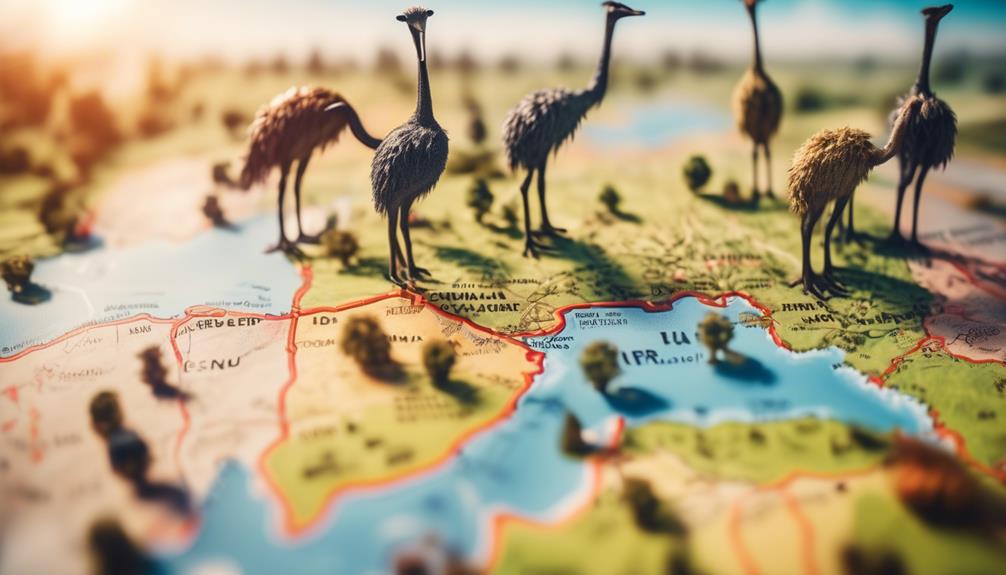
You might be wondering why you should bother learning about the global distribution of emus. After all, aren't they just native to Australia?
Well, prepare to be surprised. While Australia is indeed the primary home of these fascinating flightless birds, they can actually be found in other parts of the world as well.
In this discussion, we will explore the various continents and regions where emus have managed to establish a presence.
So, fasten your seatbelt and get ready to discover the unexpected habitats of these unique creatures.
Key Takeaways
- Emus are widely distributed throughout Australia, inhabiting various habitats across the country.
- Emus have established small populations in certain regions of Europe.
- Emus have expanded their distribution range to Asia through breeding programs.
- Emus have found a home in Oceania, including Australia, New Zealand, and Papua New Guinea.
Emus in Australia
Emus are widely distributed throughout Australia, inhabiting various habitats across the country. In the wild, these fascinating flightless birds can be found in a range of environments, from coastal regions to arid deserts, grasslands, and even forests. However, emus have also been successfully kept in captivity, providing valuable opportunities for research, conservation, and even farming.
Emus in captivity serve multiple purposes. They allow scientists to study their behavior, reproductive biology, and genetics in a controlled environment. This knowledge is crucial for conservation efforts and understanding their ecological role in the wild. Additionally, emus raised in captivity can also serve as a sustainable food source. Emu meat is lean, low in cholesterol, and high in protein, making it a healthy alternative to traditional red meats. Farmers have capitalized on this, establishing emu farms where these birds are raised for their meat, oil, feathers, and even eggs.
Emus in captivity not only contribute to scientific knowledge but also provide economic opportunities for farmers and promote sustainable food sources. By understanding the distribution and habits of emus in Australia, we can better appreciate their significance and potential in both wild and captive settings.
Emus in North America
With their success in captivity and potential as a sustainable food source, it's worth exploring the presence and impact of emus in North America. While not native to the continent, emus have gained popularity as pets and can be found in various regions. Here are some key points to consider:
- Emus as pets: Due to their unique appearance and docile nature, some individuals choose to keep emus as pets. However, it's important to note that emus require specialized care, including proper housing, nutrition, and socialization. Before considering an emu as a pet, it's crucial to research local regulations and ensure that you have the necessary resources to provide for their needs.
- Emus in zoos: Many zoos across North America feature emus as part of their exhibits. These majestic birds provide visitors with an opportunity to observe their fascinating behaviors and learn about their natural habitats. Zoos play a vital role in conservation efforts, educating the public about the importance of preserving wildlife and their ecosystems.
- Conservation efforts: While emus aren't native to North America, their presence in captivity contributes to conservation efforts. Through captive breeding programs, zoos and specialized facilities work towards maintaining healthy populations and genetic diversity. These programs also serve as a safeguard against potential threats to wild emu populations in their native habitats.
- Economic impact: The presence of emus in North America has also created economic opportunities. Emu farms have emerged, producing various products such as emu oil, meat, and feathers. These farms contribute to local economies and provide alternative sources of income for farmers.
As emus continue to captivate the hearts of individuals and find their place in zoos and farms across North America, it's crucial to ensure their well-being and contribute to their conservation.
Emus in Europe

Emus, although not native to Europe, have been introduced to the continent and have established small populations in certain regions. The presence of these majestic flightless birds in Europe can be attributed to various factors, including human intervention and conservation efforts.
Conservation efforts have played a significant role in the successful establishment of emus in Europe. Organizations and individuals dedicated to preserving wildlife have taken steps to introduce and protect emus in suitable habitats. These efforts have included breeding programs, habitat restoration, and public awareness campaigns. As a result, small populations of emus can now be found in select areas across the continent.
Emus in Europe have also become subjects of local folklore. Stories abound about encounters with these unique creatures, often portraying them as mysterious and awe-inspiring beings. These tales have contributed to the cultural significance of emus in Europe, further fueling interest in their conservation and protection.
While the presence of emus in Europe is still limited, their establishment in certain regions demonstrates the resilience and adaptability of these remarkable birds. Continued conservation efforts coupled with public support can ensure the long-term survival of emus in Europe, allowing future generations to witness their beauty and contribute to their conservation.
Emus in Africa
The introduction of emus to Europe has showcased the success of conservation efforts, and now it's important to shift our focus to their presence and impact in Africa. Emu conservation efforts in Africa have been crucial in protecting this unique and fascinating species. However, there are also several threats that emus face in this continent.
- Loss of habitat: As human populations and agriculture expand, emus are losing their natural habitat. This leads to fragmentation of their populations and limits their ability to find suitable food and shelter.
- Poaching: Emus are prized for their feathers, meat, and oil. Illegal hunting poses a significant threat to their survival, as it reduces their population and disrupts their breeding patterns.
- Climate change: Africa is experiencing the effects of climate change, including increased temperatures and changes in rainfall patterns. These changes can negatively impact emus, as they rely on specific environmental conditions for their survival.
- Predation: Emus in Africa face predation from a variety of predators, including large carnivores and birds of prey. As their natural habitat shrinks, emus become more vulnerable to predation.
Efforts to conserve emus in Africa should focus on protecting their habitats, implementing anti-poaching measures, and monitoring the impacts of climate change. By addressing these threats, we can ensure the long-term survival of emus in Africa and maintain the ecological balance of this unique continent.
Emus in Asia

Emus have established a presence in Asia, marking a significant expansion of their distribution range. In recent years, emu breeding programs have been initiated in several countries across the continent, as part of conservation efforts to protect and increase their population.
One notable example is the emu breeding program in China, where dedicated facilities have been established to breed and raise emus. These programs aim to not only conserve the species but also promote sustainable farming practices for emu products such as meat and oil.
Conservation efforts for emus in Asia have also focused on protecting their natural habitats. In countries like Australia, where emus are native, initiatives have been launched to safeguard their habitats and implement measures to minimize human-wildlife conflicts.
Additionally, collaborations between Asian countries and international organizations have been instrumental in raising awareness about emu conservation. These partnerships have facilitated the sharing of knowledge and expertise, while also promoting research and education on emus and their habitats.
As emus continue to thrive in Asia, it's crucial to maintain and expand conservation efforts. By supporting emu breeding programs and protecting their natural habitats, we can ensure the long-term survival of these remarkable birds.
Emus in South America
With their successful establishment in Asia, emus have now made their way to South America, expanding their distribution range even further. These large flightless birds have adapted well to the diverse habitats found in this continent, from the grassy plains of Argentina to the dense rainforests of Brazil. However, their presence hasn't been without its challenges.
Emus have been known to cause significant damage to agricultural crops, making them a concern for farmers in South America. To address this issue, conservation efforts have been initiated to find a balance between the preservation of emus and the protection of agricultural interests.
Conservation efforts for emus in South America:
- Implementation of wildlife management plans: These plans aim to regulate the emu population and minimize their impact on agricultural lands.
- Promotion of coexistence practices: Farmers are encouraged to adopt measures such as fencing, scare tactics, and crop diversification to deter emus from damaging their crops.
- Research on emu behavior and ecology: Understanding the behavior and ecology of emus is crucial in developing effective management strategies.
- Public awareness campaigns: Educating the public about the importance of conserving emus and the need for sustainable agricultural practices helps foster a sense of responsibility and cooperation.
Emus in Oceania

Having established themselves in various countries across the globe, emus have also found a home in the diverse landscapes of Oceania. This region, encompassing Australia, New Zealand, and Papua New Guinea, provides the emus with a range of habitats to thrive in. Let's explore the conservation efforts and cultural significance of emus in Oceania.
| Country | Conservation Efforts |
|---|---|
| Australia | The Australian government has implemented various measures to protect the emu population, including habitat conservation, predator control, and public awareness campaigns. Emus are also protected under state and federal legislation. |
| New Zealand | Emus were introduced to New Zealand in the 19th century and have since become naturalized. While they are not considered native, they are protected under the Wildlife Act of 1953. Conservation efforts focus on managing the impact of emus on agricultural lands. |
| Papua New Guinea | Emus in Papua New Guinea are mainly found in the highlands. Efforts are being made to raise awareness about their importance to the local ecosystem and culture, as well as to protect their habitats from deforestation and hunting. |
Emus hold cultural significance in Oceania, particularly in Australia, where they are considered an iconic symbol of the country's wildlife. They feature prominently in indigenous Australian folklore and art, representing a connection to the land and its ancestral spirits. Emus are also valued for their meat, oil, and feathers, which are used in traditional ceremonies and crafts. Conservation efforts in Oceania aim to ensure the long-term survival of these fascinating birds while respecting their cultural significance.
Emus in Antarctica
While Oceania has been a favorable habitat for emus, their presence in Antarctica is non-existent due to the extreme and inhospitable conditions of the continent. Antarctica is characterized by its icy landscape, freezing temperatures, and strong winds, making it unsuitable for the survival of emus.
- Extreme Cold: Emus aren't equipped to withstand the extreme cold temperatures that can drop to as low as -80 degrees Celsius in Antarctica. Their feathers aren't thick enough to provide sufficient insulation, and they lack the physiological adaptations necessary to regulate their body temperature in such harsh conditions.
- Lack of Vegetation: Antarctica is largely devoid of vegetation, with only a few mosses and lichens able to survive. Emus primarily rely on a herbivorous diet, consuming various plant materials for sustenance. The absence of suitable food sources in Antarctica would pose a significant challenge to their survival.
- Limited Water Availability: Emus require access to water for drinking and bathing. In Antarctica, most of the water is in the form of ice, and the availability of liquid water is scarce. This lack of water sources would further hinder the survival of emus in this environment.
- Predator Absence: Emus have evolved to coexist with certain predators in their natural habitats. However, Antarctica is devoid of any terrestrial predators, which may have contributed to the absence of emus on the continent.
Frequently Asked Questions
Are Emus Native to Any Other Continent Besides Australia?
Emus, native to Australia, are not found naturally on any other continent. However, there have been efforts to introduce them in Europe and conserve them in North America, expanding their global distribution.
Are Emus Considered an Endangered Species in Any Part of the World?
Emus are not considered endangered in any part of the world. However, conservation efforts are in place to protect their habitats and ensure their population remains stable.
Do Emus Have Any Natural Predators in the Areas Where They Are Found?
Emus do have natural predators in the areas where they are found. These predators, such as dingoes and feral dogs, pose a threat to emus, especially their eggs and young offspring.
Are There Any Cultural or Traditional Beliefs Associated With Emus in Different Parts of the World?
Emus hold cultural significance and traditional beliefs in various parts of the world. From Aboriginal dreamtime stories in Australia to spiritual symbolism in Native American cultures, emus have woven themselves into the fabric of human beliefs and traditions.
How Do Emus Adapt to Different Climates and Environments in the Regions They Inhabit?
Emus have remarkable adaptation strategies to thrive in various climates and environments. They select habitats based on factors like food availability, temperature, and vegetation cover. Their ability to adjust to different conditions ensures their survival across regions.
Conclusion
In conclusion, Emus can be found in various regions across the globe, including Australia, North America, Europe, Africa, Asia, South America, Oceania, and even Antarctica.
One fascinating example is the case of a hypothetical research expedition to Antarctica, where scientists discovered a small population of emus surviving in the harsh conditions of the continent.
This highlights the adaptability and resilience of these remarkable flightless birds, as they continue to thrive in diverse environments around the world.




